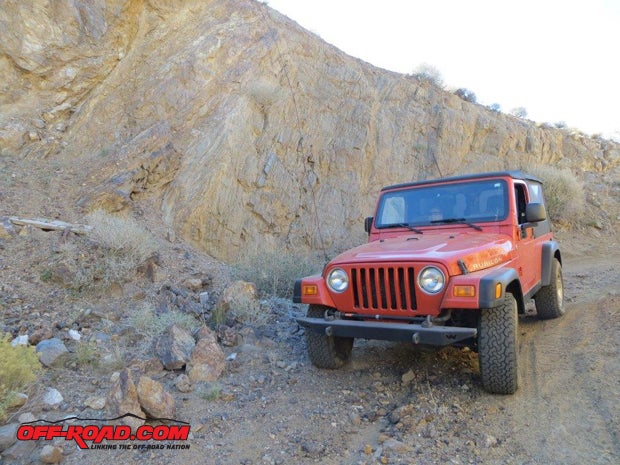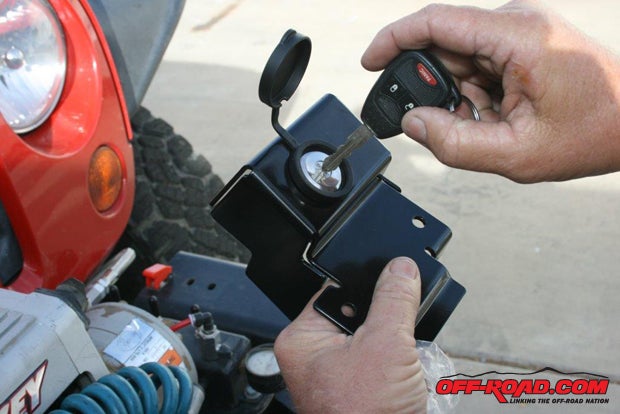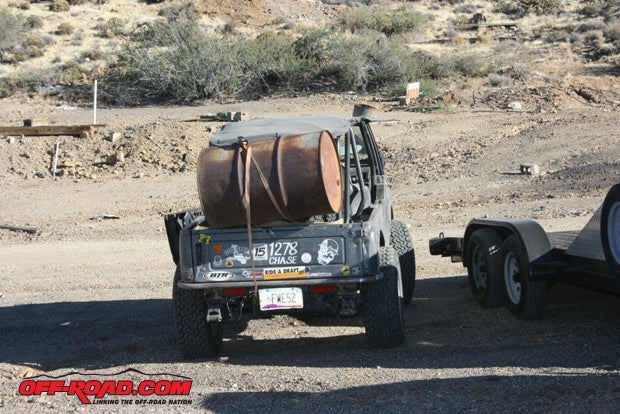Jeep Creep: Cherokee Towing, Shock Replacement and Trail Bag Items

In your Jeep Creep questions, please list your first and last names, your hometown, and your state/province/country, so that we can publish that information here. If you donít provide this information, we may not be able to publish your question and answer. Donít forget to be as complete as possible with the description of your Jeep and its problems, too. Send your Jeep questions to editor@off-road.com, Attn: Jeep Creep.
PREVIOUS JEEP CREEP COLUMNS
November 2014
No Jeep recalls from NHTSA this month
Cherokee Towing Problem
I am experiencing a problem with the steering axle of my 2014 Jeep Cherokee Limited. While towing, when I encounter a rough or rutted road surface, the Jeepís steering axle will violently shake. This has happened at speeds of 30 and 55 mph. To stop the shaking I need to come to a complete stop. I have talked to a couple of dealers and have been told that the steering column lock is not factory installed on this model and according to one dealership, it is not available as an add-on option either. I am looking for a solution to this problem. Any suggestions? Thank you.
Jerry Halberg
Florida
Among the off-road community, Jerry, what youíre experiencing is called ďthe death wobble.Ē Since you didnít include your city, Iím giving you a link to the 4 Wheel Parts store locator (www.4wheelparts.com); there are several stores in Florida so one should be fairly close to you. As your Jeep is a 2014 I would normally send you to a dealership for your problem correction, but it appears that youíve already tried that route. I donít think your wobble problem is caused by your tow bar assembly. I believe itís in the Jeepís steering and/or suspension systems. First of all, make sure your tires are balanced as well as they can be. Take it to major tire chain and have them high-speed spin balanced, then try towing. If the wobble isnít corrected, take it the nearest 4WDH store and ask them the check alignment, toe, etc., and ask them to tighten every nut and bolt in the entire suspension systemóespecially in the frontóand one or the other should correct your wobble problem without having to change the tow bar system.
Rusty Shocks
I live on Cape Cod and I do a lot of beach running and fishing with my í06 Wrangler. It has over 90,000 miles on the odometer, not to mention the towing miles behind my motorhome (mileage doesnít add up with the key off). The Jeep started wallowing on the highway, especially with my aluminum skiff hooked on the back. Because of the way I use the Jeep (surf-fishing on the beach, in the snow going to work, and family camping here in New England), I donít want to raise it so I looked around for standard replacement shock absorbers. I found some at OíReilly Auto Parts. But when I went to change out the shocks I found out that between the winter salt and the Cape Cod beach salt, the underside of my Jeep is pretty rusty and Iím afraid to try and bust the bolts loose without using something to break up the rust.
Jesse Duke
Provincetown, MA
The best thing Iíve found, Jesse, is an aerosol spray called PD Blaster. It has the strength to cut rust very well and its thin stream of spray lets you soak down bolts inside the frame by spraying through the holes in the frame. If itís really bad, soak the area really well a few days before you try to break the bolts loose. Say, spray them on Wednesday night if youíre going to work on the Jeep on Saturday, and then recoat the area again on both Thursday and Friday nights. This should do it for you. Once youíve removed the old shocks, coat everything under your Jeep with Rust-Oleum spray paint. Rust-Oleum stops rust in its tracks, but you might need a lot of it. Use several coats so you make sure you get it in all the nooks and crannies under the Jeep.
Low Seats
Jeep Creep, whatís up with TJís seats? My TJ was my first Jeep so I thought all Jeep seats were low. Iím over six feet and I have trouble even seeing the front edge of the hood. I rode in a friendís í08 JK the other day and, oh my, what great seats! His seats could even be pumped up higher than usual with a lever on the side. If I can find a wrecked JK, will its front seats fit in my TJ?
Jim Conner
Corpus Christi, TX
I donít think the JK seats will fit in the narrow cabin of the TJ, Jim, unless you were willing to give up the center console. JKs are quite a bit wider than TJs. However, I think I have a solution for you. Buchanan Precision Machine in Ventura County, California, offer seat riser kits in three heights: 1-inch, 1-1/2-inch, and 2-inch. They are available at 4 Wheel Parts (www.4wheelparts.com).
#
Maintenance and Detailing
I donít live in the desert; I live in New Jersey. I like wheeling in the Pine Barrens and we donít get scratches, we get chips and dings. I work in the city so I like to keep my Jeep well maintained and detailed. In other words, I wheel on Saturday and clean it between football games on Sunday. Can you give me any hints or ideas on making it easier to keep the Jeep up?
Dr. Robert Nelson
Trenton, NJ
Iím not sure what you can do about the dings, Dr. Nelson, except to suggest missing the trees and rocks. However, small cosmetic repairs donít require a costly trip to the body shop. By using the right tools and techniques you can get rid of nicks and scratches in your own garage. AutomotiveTouchup offers a solution for this, as the company custom formulates exact-match touch-up paints for thousands of cars and trucks using its library of OEM colors. The key to the perfect color match is contained in the vehicleís color code. The trick is finding it, since it can be located in a number of places, with the inside of the door being the most common. AutomotiveTouchup formulates touch-up products to work together as part of a complete automotive paint system, and it recommends using primer, basecoat and clear coat from the same brand. Completing your touch-up project with clear coat is an essential finishing step--nail polish is no substitute for a real clear coat product. The company offers pens for small rock chips and nicks smaller than a pencil eraser; its bottles work for small areas no larger than a dime, and a half-ounce bottle is sufficient for most small touch-up projects; and for bigger areas, a single 12-ounce aerosol can will cover about a 6-square-foot area.
Before you do any type of repair, it is important to test the color match of the touch-up paint and compare it to the vehicleís existing paint. AutomotiveTouchup encloses a test card with each order to preview the color before applying, and a how-to video on their website will offer additional assistance. For simple pen and bottle touch-ups, a pair of disposable gloves might be all that is needed. When the project involves more repair steps and aerosol products, additional materials can include body filler, sandpaper, dust mask or respirator, safety glasses, prep solvent, adhesion promoter, masking tape or masking film, tack cloth and rubbing compound. Thoroughly clean the area to be repaired with dish soap (Joy, Dawn, Fels-naptha, etc.) and water before painting to remove wax, silicone and oils. Regular car soap often has a car wax so this product should not be used. Use prep solvent and a clean lint-free towel to assure the surface is free of wax, silicone, and oils.
If primer is needed, for plastic and fiberglass parts, before priming use a plastic parts adhesion promoter over bare plastic or fiberglass. (Note: this is only required for aerosol paints, not pens or bottles). Apply three or more coats of primer, allowing five to ten minutes of dry time in between coats.
The next step is the basecoat. Thoroughly shake the basecoat color pen, bottle or spray can before applying. Spray a test panel with basecoat and clear coat first to compare color match and coverage. Apply as many medium coats necessary to cover the area, waiting five to ten minutes minimum between light coats. Wait 30 minutes before using clear coat. Then, apply two to four wet coats of clear coat, waiting five to 10 minutes in between coats for aerosol and 10 to 20 minutes for bottles and pens. With these brush-on products, be gentle with the brush so the undercoats are not disturbed. Clear coat should be dry to the touch in one to two hours but will completely dry overnight. Wait one day to use rubbing compound for an optimum gloss level.
Practice using touch-up paint before applying, to get a feel for the paint and to check the color match. Use a glossy sheet of paper or metal can as a practice surface. Apply in an area with adequate ventilation. For aerosol, the ideal temperature for spraying is 70 to 80 degrees F. Use several light coats rather than one heavy coat. Allow the correct amount of drying time. Drying times can vary depending on the temperature. If the temperature is below 70°F, the paint can take longer to dry. Do not spray primer, paint or clear coat in direct sunlight. Do not wax Jeep for at least 30 days. See www.AutomotiveTouchup.com for more details.

Need More Security
Itís me again, Joey Rodriguez. If you remember I asked you about a hardtop for a 2007 Rubicon two-door and the Rally Tops hardtop you recommended worked out great. Working in downtown El Paso, Texas, my Jeep had been broken into (somebody sliced the soft top to get inside). I havenít had a problem since I installed the top and my kids really enjoy the sliding side windows. Now though Iím worried about leaving my engine compartment unprotected, and I donít want to lose my battery. Can you help me?
Joey Rodriguez
El Paso, TX
Joey, I recently heard about a new product from Bolt. Itís a hood lock for JK model Jeeps that allows you to match your ignition key to the lock so you wonít have to add more keys to your ring. I havenít seen one mounted but I do know itís installed using some humongous pop rivets. Youíll have to buy a large pop rivet gun to accommodate the pull shafts on the pop rivets. Itís available at Summit Racing, along with other Bolt products that can be matched to your Jeepís ignition key. Iíve used several of Boltís products and they are all well designed and well built.

Go Bag
I recently bought a used Jeep. Itís my first, so Iím wondering what I need to equip it with. I donít mean camping gear or mechanical modifications (itís a Rubicon so Iíve already got a head start on the mechanical stuff). I mean stuff that Iíll need or could need on the trail, such as a Hi-Lift Jack, etc. And should I get a winch?
Lee Holtsfeld
Germantown, PA
My second four-wheeler had a winch, but my first one didnít. Both my Jeeps now have them because of the types of trails we use them on. If you donít go soloówhich you definitely shouldnít doóitíll be several years, probably, before youíll benefit from having a winch. Besides, it seems that a winch is used on other people much more often than on your own Jeep. However, you definitely need a good recovery strap (rated for at least 20,000 pounds) and strong attachment, safe points on both ends of your Rubi. Buy a new fan belt(s) and either replace the current fan belt and save it, or save the new fan belt in a Ziploc bag store it in the Jeep. Iíve never seen a fan belt brake in the driveway or garage and it can put you completely out of action without a replacement on the trail. A set of handtools in a secure, heavy-duty plastic case will come in handy, as will an air compressor and tire puncture repair kit. To round-out your go bag, a box of strike-anywhere matches, a bar of Fels-naptha soap (available at hardware stores; it will stop a gas tank leak by rubbing it over the leak aggressively), toilet paper, a small shovel, and an air pressure gauge. As you encounter a problem on the trail, and if you donít have a fix at hand, make note of it and add that item to your go bag when you get back to civilization. By the way: Iíd love to see some additional suggestions to this list from you readers. Email them in and weíll post them.
Jeep Tires
How big of a tire can I put on stock wheels on a 2012 stock Jeep?
Noel Rowe
I believe stock JKs come with different width wheels depending upon the model, and I hope youíre talking about a Wrangler and not a Liberty or Grand Cherokee. Rubicons come with 32-inch tires, so Iíd suggest 10.50x33x17 (or in metric a 305) would be as large as you can go without modifying the Jeep. If you do go that big, make sure the steering stops keep the tires from rubbing on the frame or control arms. From the factory the nuts are welded to the bolt but you can add another nut if needed.
I have a request of all the readers out there. Send us your questions. For some reason the questions have fallen off, and I know we havenít answered all your Jeep technical questions. There are no dumb questions; only unasked questions. Send them in and try to stump us.óJim Brightly
As usual, each month, Iím shouting out a huge THANK YOU to Paul Schupp at Rock Lizard 4x4 in Kingman, Arizona, for his invaluable assistance in answering many of the Jeep Creep questions.


 Your Privacy Choices
Your Privacy Choices